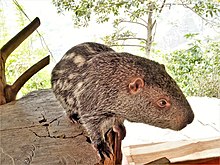
Back باكارانا Arabic باكارانا ARZ Evuskol (Dinomys branickii) AVK Pakarana Azerbaijani Пакарана Bulgarian Pakarana Breton Pacaranà Catalan Dinomys branickii CEB Pakarana Czech Pakarana German
You can help expand this article with text translated from the corresponding article in Polish. (04 2023) Click [show] for important translation instructions.
|
| Pacarana | |
|---|---|

| |
| Santa María del Mar District, Peru | |
| Scientific classification | |
| Domain: | Eukaryota |
| Kingdom: | Animalia |
| Phylum: | Chordata |
| Class: | Mammalia |
| Order: | Rodentia |
| Family: | Dinomyidae |
| Genus: | Dinomys Peters, 1873 |
| Species: | D. branickii
|
| Binomial name | |
| Dinomys branickii Peters, 1873
| |

| |
The pacarana (Dinomys branickii) is a rare and slow-moving hystricognath rodent indigenous to South America. Native Tupi people call it the pacarana (false paca) because it is superficially similar to the paca, a different rodent which is not in the same family. The pacarana has a chunky body and is large for a rodent, weighing up to 15 kg (33 lb) and measuring up to 79 cm (2 ft 7 in) in length, not including the thick, furry tail.[2][3]
The pacarana is nocturnal and is found only in tropical forests of the western Amazon River basin and adjacent foothills of the Andes Mountains. It ranges from northwestern Venezuela and Colombia to western Bolivia, including the Yungas. It is common in Cotapata National Park in Bolivia.[1]
The pacarana is the sole extant member of the rodent family Dinomyidae in the infraorder Caviomorpha; the paca that it resembles in appearance is in a different Caviomorph family, the Cuniculidae. Initially, the pacarana was regarded as a member of the superfamily Muroidea, that includes the true mice, but that view was abandoned in the face of evidence that suggests that the pacarana is in the family Dinomyidae together with extinct animals such as Phoberomys pattersoni and Josephoartigasia monesi, prehistoric giant rodents that lived in South America several million years ago.
Pacaranas typically are found in family groups of four or five.[4]
- ^ a b Roach, N. (2017). "Dinomys branickii". IUCN Red List of Threatened Species. 2017: e.T6608A22199194. doi:10.2305/IUCN.UK.2017-2.RLTS.T6608A22199194.en. Retrieved 19 November 2021.
- ^ Nguyen, Khoa Huu. "Dinomys branickii (pacarana)". Animal Diversity Web. Retrieved 2019-07-17.
- ^ "Mammalian Species" (PDF). 2016-03-03. Archived from the original (PDF) on 2016-03-03. Retrieved 2019-07-17.
- ^ Saavedra-Rodríguez, Carlos A. "Multiscale patterns of habitat and space use by the pacarana Dinomys branickii: factors limiting its distribution and abundance" (PDF). Inter-Research 2012. Retrieved 18 January 2013.
